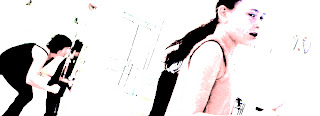~~~~~~~~~~~~~~~~~~~~~~~~~~~~~~~~~~~~~~~~~~~
Click here to watch "In the Red Tent" -
http://youtu.be/Ef6KlfWmjFg
~~~~~~~~~~~~~~~~~~~~~~~~~~~~~~~~~~~~~~~~~~~
It all started when Emily gave me her old curtains... scarlet tulle with three inch metallic gold trim. "I thought you might use these for your improv dance group."
Indeed!
MENSTRUAL HOUSES-- A FEMININE HERITAGE
 |
| From "In the Red Tent" |
So from Emily's old curtains MAE built an environment which turned out to be a red tent. In fact, it became THE red tent of the book, "The Red Tent," by Anita Diament. Diament's fictional red Arabian tent was inspired by traditional menstrual structures-- huts, tents, cabanas, houses, and other dwellings of endless names, from the beginning of human time. Thoroughly feminine spaces, these huts were structures for women to retire to during their monthly cycles.
The male-dominated fields of archeology and anthropology (which never had useful access to the surviving menstrual huts of contemporary indigenous cultures, because they were, after all, well... male.) But these men of science described the women's experiences anyway, surmising that in general the menstrual houses existed because of "primitive" beliefs that women are unclean during their periods, dangerous, and capable of contaminating material objects, as well as food, and of causing sickness if not fatality. Therefore, they had to be "confined" away from the communities during their menstrual flow.
Later, female scientists, being granted access to the huts and more intimate contact with the women there, described things quite differently. They found that the women themselves characterized their experience of the menstrual hut as a place where women felt free to behave in ways they ordinarily didn't. In the hut, which they designated the holiest structure in the village, the women conducted their own purification ceremonies, and made their own ritual offerings. They were more open about sexuality & reproduction, and talked more candidly about husbands and mothers-in-law. The could be more playful and physically rough, they could smoke cigarettes, sleep late, take naps, drink endless cups of tea, flirt with passersby, and sing and dance simply for the joy of it. It was a place of intermittent escape. It provided women (young & old, post-menstrual as well as menstruating women) with a place from which to act-- to resolve village issues, to be creative and religious; to be part of the larger community of only women from which they were usually divided by family, village and household responsibilities. The menstrual huts were a place of constant flow of people and things coming in and out, as supplies were delivered: food, firewood, bedding, cooking utensils, goddess figurines, women, and ritual items all came in from the outside.

And of course everyone, men and women alike, was born in the menstrual hut-- the red tent-- and thus
brought out from the inside. In other words, the spaces symbolized by the Red Tent, were where women experienced an expanded sense of themselves as effective agents and as free people. The structures offered a respite from day to day work, and a space for laughter, affection, long lazy naps, and extra cups of tea. Here, they delivered babies and even slew a few dragons. (Google: Menstrual Houses, "The Kalasha Bashali")
OUR OWN RED TENT:
 |
| Betty Backus, from "In the Red Tent" |
When Emily's curtains transformed into our own Red Tent, and we began to move within it, how free our movements quickly became, how sensual and ecstatic. How the emotions of tenderness for each other seemed to arise as we gently stroked each others checks, touched hair and shoulders as one would a beloved mother or child, and as we embraced, silently asking for, receiving and giving gentleness, nurturing and comfort.
 |
| Gwyn Henry, from "In the Red Tent" |
How beautiful I felt as we danced in that red tent, and how beautiful the other three women became in its glow, as if the fabric itself had attracted the energy of a Goddess, which nestled in the brilliant, diaphanous woven threads that surrounded us.
 |
| Tanya Notkoff, from "In the Red Tent" |
For me, the Studio itself fell away, and a briliant desert surrounded us while the sound of camel bells seemed to hang in the air along with intoxicating incense, and a feeling of ultimate feminine joy and power-- ours to be given to the waiting World.
 |
| Yulia White from "In the Red Tent" |






















